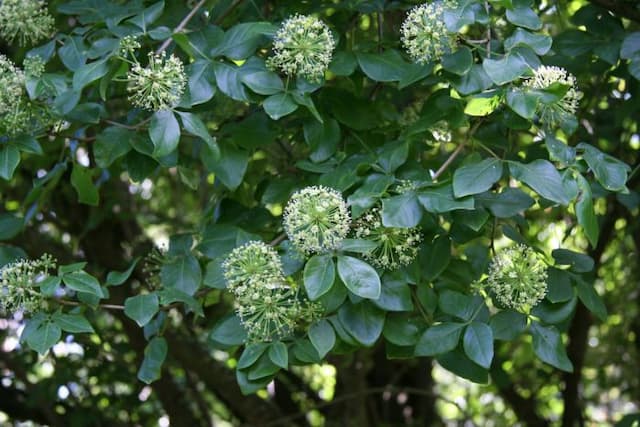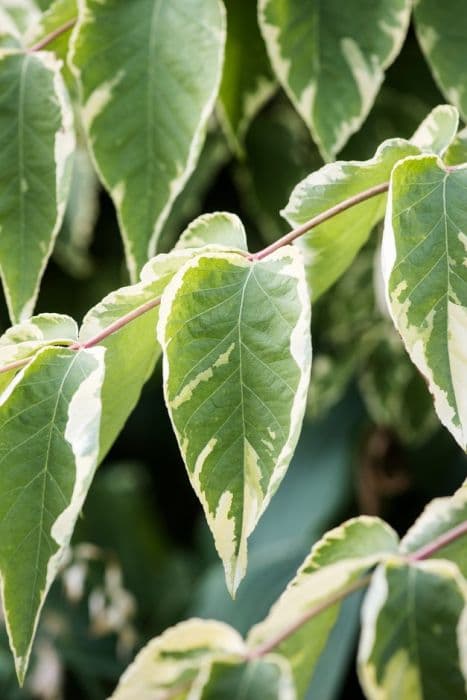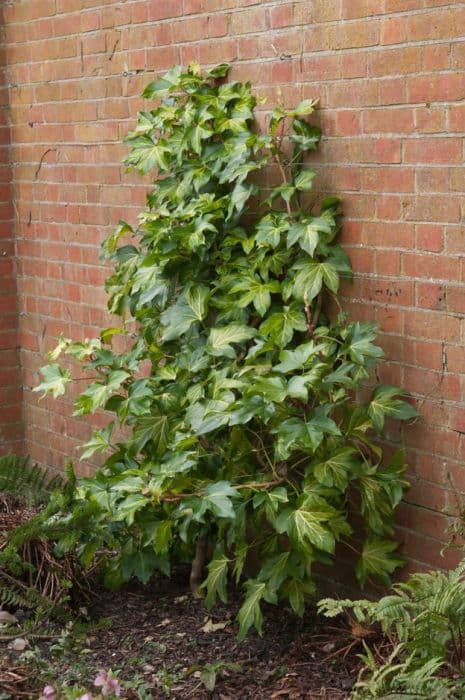Persian Ivy Hedera colchica 'Dentata Variegata' (v)

ABOUT
Hedera colchica 'Dentata Variegata', commonly known as the Persian Ivy, is a visually striking variegated variety that is often grown for its ornamental appeal. Leaves on this plant are large, somewhat heart-shaped with an attractive point, and feature a bold pattern. The variegation includes a combination of deep green centers surrounded by a creamy yellow to white margin, giving it a vibrant, contrasting look. The leaves have a slight waviness to them and can have a leathery texture. Persian Ivy is evergreen, ensuring year-round interest in the garden or indoor spaces. The edges of the leaves are irregularly serrated, giving them a somewhat toothed appearance, hence the name 'Dentata.' This contoured edging contributes to the plant's ornamental value. The variegation pattern on the leaves may vary, with some leaves having more white or cream than green, and others more uniformly green, but the overall impression is of a light and bright foliage display. During its blooming period, the Persian Ivy can produce small, inconspicuous clusters of flowers, which are not typically the main attraction of this plant. Rather, it is grown for the striking foliage which can drape elegantly when planted in a hanging basket or can climb when given support, adding a lush, textured appearance to walls, trellises, or other structures in the landscape.
About this plant
 Names
NamesSynonyms
Persian Ivy, Colchis Ivy, Variegated Persian Ivy, Dentata Variegated Ivy.
Common names
Hedera colchica 'Dentata Variegata' (v).
 Toxicity
ToxicityTo humans
The plant commonly known as Persian Ivy is toxic to humans. If ingested, the toxicity may cause symptoms such as gastrointestinal discomfort, diarrhea, vomiting, and hyper-salivation. In addition, contact with the skin can sometimes result in dermatitis or a rash.
To pets
Persian Ivy is also toxic to pets, including cats and dogs. If pets ingest this plant, they may experience vomiting, abdominal pain, hypersalivation, and diarrhea. In severe cases, ingestion can lead to ataxia, which is a loss of control of body movements. It is important to prevent pets from having access to this plant due to its potential toxicity.
 Characteristics
CharacteristicsLife cycle
Perennials
Foliage type
Evergreen
Color of leaves
Variegated
Height
10 feet (3 meters)
Spread
10 feet (3 meters)
Plant type
Climber
Hardiness zones
6
Native area
Caucasus
Benefits
 General Benefits
General Benefits- Ornamental Value: The Persian ivy 'Dentata Variegata' has variegated leaves that add visual interest to gardens and landscapes.
- Drought Tolerance: Once established, it can tolerate periods of dry conditions.
- Shade Tolerance: This variety can grow in shaded areas where other plants might not thrive.
- Wall and Fence Coverage: It can be used to cover unsightly walls and fences.
- Soil Erosion Control: This ivy's dense growth habit helps prevent soil erosion on slopes and banks.
- Low Maintenance: The plant requires minimal care once established, making it ideal for busy gardeners.
- Adaptability: It can adapt to a range of soil types, from clay to loam and sand.
- Wildlife Support: Provides habitat and sometimes food for certain species of birds and insects.
 Medical Properties
Medical PropertiesThis plant is not used for medical purposes.
 Air-purifying Qualities
Air-purifying QualitiesThis plant is not specifically known for air purifying qualities.
 Other Uses
Other Uses- Hedera colchica 'Dentata Variegata', commonly known as Persian ivy, can be used as a natural dye source. Its leaves can produce a range of green to brown dyes for textiles and crafts.
- Persian ivy leaves can be used in the creation of leaf prints or nature-inspired art, taking advantage of the variegated patterns to create unique designs.
- The thick growth of Persian ivy can provide a natural sound barrier when grown against walls or fences, helping to reduce noise pollution.
- With its climbing habit, Persian ivy can be trained to grow over unsightly objects, such as utility boxes or old stumps, camouflaging them in the landscape.
- Persian ivy can be used in themed gardens, such as a Shakespearean or medieval garden, due to its old-world charm and association with traditional English gardens.
- In cooler climates, the Persian ivy can be grown indoors in hanging baskets to add a touch of greenery to interior spaces.
- Its dense growth habit makes Persian ivy an excellent candidate for topiary or living sculptures in gardens and parks.
- Persian ivy can be utilized as a living mulch under large trees or shrubs, where other plants may struggle to grow due to lack of sunlight.
- Educational projects can use Persian ivy to teach about plant propagation techniques, as it can be easily propagated from cuttings.
- When dried and varnished, the leaves of Persian ivy can be used in crafting, such as making decorative bookmarks or adding to potpourri mixes.
Interesting Facts
 Feng Shui
Feng ShuiThe Persian ivy is not used in Feng Shui practice.
 Zodiac Sign Compitability
Zodiac Sign CompitabilityThe Persian ivy is not used in astrology practice.
 Plant Symbolism
Plant Symbolism- Connection: As a variety of ivy, Hedera colchica 'Dentata Variegata', commonly known as Persian Ivy, tends to cling and grow along surfaces, symbolizing the idea of sticking together and holding on through various conditions, much like interpersonal connections and relationships.
- Protection: Ivy often forms a dense covering, which can symbolize safety and protection. In some traditions, it was thought to protect against negative energy and spirits.
- Eternity: Persian Ivy is evergreen, symbolizing eternal life or immortality. This reflects the idea of enduring and ongoing nature of life, continuity, and perseverance.
- Fidelity: Due to its clinging nature, ivy is often a symbol of fidelity and loyalty in relationships, suggesting a sticking by one another through all conditions.
- Growth: This plant's vigorous growing habit can represent personal or spiritual growth, and the perseverance needed to continue growing against all odds.
 Water
WaterPersian Ivy requires consistent moisture, but it should not be waterlogged. Water the plant thoroughly when the top inch of the soil feels dry to the touch, approximately once a week. Depending on the size of the plant and the humidity level of the environment, the plant may need around 16 ounces of water each time during active growth periods in spring and summer. Reduce watering in fall and winter, allowing the topsoil to dry out a bit more between waterings. Overwatering can lead to root rot, so be cautious and adjust the frequency based on the plant's response and seasonal changes.
 Light
LightPersian Ivy prefers bright, indirect light but can also tolerate partial shade. It should be kept out of direct sunlight, which can scorch its leaves. The best spot for the plant would be a location that receives filtered or dappled light throughout the day, such as near a north-facing window or a few feet away from a south or west-facing window with a sheer curtain.
 Temperature
TemperaturePersian Ivy thrives in a temperature range of 50°F to 70°F, making it well-suited for typical indoor environments. The plant can survive minimum temperatures of around 30°F but will start to suffer damage if exposed to frost or prolonged cold. The ideal temperature conditions for active growth are between 60°F and 70°F.
 Pruning
PruningPruning Persian Ivy helps to maintain its shape, encourage fuller growth, and remove any damaged or diseased foliage. It is best to prune the plant in the spring, just before new growth begins. This can be done once a year or more frequently if the plant is growing vigorously and becomes too large for its space. Cut back any long, leggy vines to promote a bushier appearance, making sure to use clean, sharp scissors or pruning shears.
 Cleaning
CleaningAs needed
 Soil
SoilPersian Ivy 'Dentata Variegata' thrives in well-draining soil rich in organic matter, with a pH between 5.5 and 7.5. A mixture composed of two parts peat or coco coir, one part perlite, and one part compost is ideal for ensuring proper nutrition and drainage.
 Repotting
RepottingPersian Ivy 'Dentata Variegata' should be repotted every two to three years to prevent root-bound conditions and replenish nutrients in the soil. Younger, faster-growing plants may require more frequent repotting.
 Humidity & Misting
Humidity & MistingPersian Ivy 'Dentata Variegata' prefers a moderate humidity level of around 40-50%. It can tolerate lower humidity but thrives in environments that replicate its natural humid habitat.
 Suitable locations
Suitable locationsIndoor
Provide bright, indirect light and maintain even moisture.
Outdoor
Plant in partial shade; shelter from harsh sun and wind.
Hardiness zone
6-9 USDA
 Life cycle
Life cyclePersian Ivy 'Dentata Variegata' begins its life as a seed, which, when sown in spring or early summer, germinates in warm soil with adequate moisture. Upon germination, the seedling emerges and establishes a small root system and begins to grow heart-shaped, variegated leaves. As a juvenile, the plant exhibits rapid vegetative growth and climbs by means of aerial rootlets if it has support, or it can spread horizontally as ground cover if left to trail. In its mature phase, which can be several years after germination, the vine develops woody stems and can produce small, inconspicuous greenish-yellow flowers in late summer to autumn if provided with the right growing conditions. After flowering, the plant may produce small, black-berry like fruits, which are typically not viable for germination under cultivation. Throughout its life, this evergreen perennial will continue to grow and spread, requiring pruning to manage its growth and to maintain its attractive variegated foliage.
 Propogation
PropogationPropogation time
Spring-Early Summer
The Persian Ivy 'Dentata Variegata', a variegated cultivar of Hedera colchica, is commonly propagated through stem cuttings. The best time to take cuttings for propagation is during late spring through early summer when the plant is actively growing. To propagate, select a healthy stem with several leaves and cut it just below a node, where the leaf meets the stem. This section should be about 4 to 6 inches long (approximately 10 to 15 centimeters). Remove the leaves from the bottom half of the cutting to expose the nodes, as this is where roots will develop. Dip the cut end into rooting hormone to encourage root growth and plant it in a well-draining potting mix. The cutting should be kept moist but not waterlogged and placed in indirect light until roots have established, which usually takes a few weeks. Once rooted, the new Persian Ivy plant can be transplanted to a permanent location.









